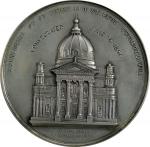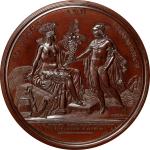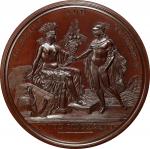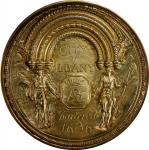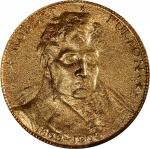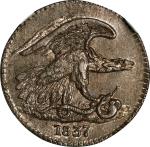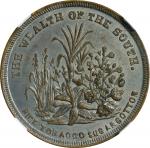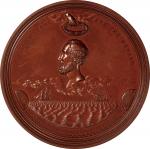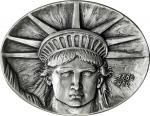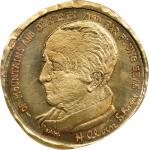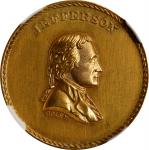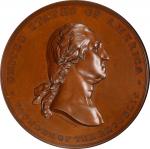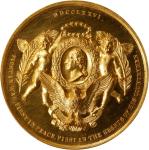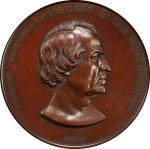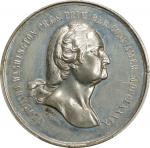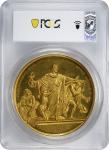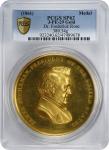(1861) Congressional Gold Medal to Dr. Frederick Rose. Julian PE-29, Milford Haven 627. Gold. MS-62 (PCGS). 76 mm, 7.4 mm to 8.1 mm thick at the rims. 5,867.0 grains. An extraordinary historical monument, a unique medal, of the highest interest to collectors of the finest American historical medals or anyone with an enthusiasm for medical or naval history. Authorized by Congress on May 11, 1858, this was the first Congressional Gold Medal ever awarded to a recipient who was not a member of the United States military. It was, however, awarded for extraordinary humanitarian service to the sailors aboard the <em>U.S.S. Susquehanna</em> as the crew battled the scourge of yellow fever.<p>This medal is majestic and immense, a testament to the caliber of work the United States Mint was capable of in the mid 19th century. The deeply mirrored fields are a rich shade of bright yellow-gold, protected by rims that stand nearly a full millimeter taller than the surfaces. The medal is nicely frosted on the portrait and other devices, and an attractive orange peel texture becomes bolder as it approaches the periphery. The eye appeal suggests Gem quality, with only a few minor signs of handling, including a tiny rim nick on the reverse below 9 oclock, some faint hairlines that are vanishingly trivial but appear visible against the prooflike fields, and a light abrasion right of Buchanans forehead. The obverse die is cracked somewhat prominently through Buchanans portrait, from just below his eye, downward across his forward cheek and through the first three collars, ending at the upper edge of the broad coat collar. On the reverse, a minor rim crack that begins atop the rim over the letter A in NAVY extends down into the field, ending just right of the A of that word.<p>When this was sold in a Spink Medal Auctions sale in London in July 1988, it was cataloged as follows:<p><em>U.S.A. Presidential gold medal to Dr. Frederick Rose, R.N. A 75mm. dia. gold medal, weight 380 grammes, by F. (sic) Paquet. Obverse, A fine high relief bust of James Buchanan and surrounded by the words James Buchanan, President of the United States. Reverse, Aesculapius holding a bowl and a serpent shield a man and a woman from a figure of Death, with above To Dr. Frederick Rose, Assistant Surgeon, Royal Navy, G.B. and below for his kindness and humanity to officers and crew of the U.S. Steamer Susquehanna, weight 12.3ozs. troy. Contained in the original fine gold morocco leather case inscribed The President of the United States to Dr. Frederick Rose Royal Navy. A unique medal. Ex Christies, Oct. 1958.</em><p>Though authorized in May 1858, no work was undertaken in delivering this medal to Dr. Rose until June 1860, when the State Department finally reached out to the Mint Director to create a medal that could be presented to the recipient. Anthony C. Paquet executed the dies, using a similar portrait of Buchanan to that seen on his 1857 Japanese Embassy medal. The reverse die was the final work executed, and soon after its completion in early February 1861 this precise medal was struck for presentation to Dr. Rose.<p>Dr. Frederick Rose was a physician and Royal Navy officer with the rank of Assistant Surgeon. He was in Jamaica in 1858, when he earned this medal for a selfless act of bravery that saved American lives.<p>Rose to the opportunity for uncommon heroism at Port Royal on April 5, 1858, with the arrival of a ship full of very sick United States Navy personnel. The <em>USS Susquehanna</em> was a side-wheel steam frigate, first commissioned in 1850 as the flagship of the East India Squadron. She was present with Perrys initial expedition to Japan in 1853. In the spring of 1858, she was dispatched from her patrol on the Mediterranean to the coast of Central America in the wake of William Walkers filibustering. "The Susquehanna had been ordered from the Mediterranean, six months ago, to Greytown, Central America, in consequence of Walkers movement in that quarter," recounted an unsigned letter published in the <em>Alexandria</em> (VA) <em>Gazette</em> on April 19, 1858. "She arrived too late to take part in the expedition that led to his capture, but her orders obliged here to lay in that harbor - a place subject to influences of a deadly character, in the way of miasma, produced by lagoons of fresh water, many of them stagnant."<p>What those lagoons contained were not miasmas, toxic vapors that were responsible for human disease. They contained mosquitos. And while Germ Theory would take hold as the prevailing understanding in the field of epidemiology in the upcoming decades, the connection between yellow fever and a virus carried by mosquitos was not yet understood.<p>The first fatalities aboard the <em>Susquehanna</em> happened soon after the discovery of the fever on board on March 19, 1858. Eleven days later, with "some four officers and upwards of forty men" befouled by the virus, the decision was made to leave its anchorage off Nicaragua and head toward the closest American naval hospital at Pensacola. Once en route, the ship discovered it was low on coal, and pulled into Port Royal, Jamaica. It was there that those aboard encountered Dr. Frederick Rose. By the time the <em>Susquehanna</em> arrived, 70 men were sick with yellow fever.<p>With permission from Roses commanding officer, the Royal Navy surgeon volunteered his services to the endangered American vessel. Half the crew ended up sick, about 150 men. At great person risk, Dr. Rose accompanied the vessel to New York while administering treatment to the men aboard. Once he arrived, he became the toast of the nation, and word that the United States Congress voted him a gold medal appeared in newspapers from coast to coast.<p>Though the medal would not be handed off to Dr. Rose for years, it was clearly cherished after its presentation by Rose himself and his descendants. The impressive maroon leather presentation case by Ignatius Kohler, bookbinder of Philadelphia, tooled with gilt designs from American coins and other motifs, was preserved with care and still houses the medal as part of this offering. The case measures 7.1875 inches square, is 1 inch thick, with an interior leaf that is 0.6875 inches thick. On the exterior lid of the case is printed in gilt lettering THE / PRESIDENT / OF THE UNITED STATES / TO / DR . FREDERICK ROSE / ROYAL NAVY. The makers name, IG. KOHLER BOOKBINDER PHILADELPHIA, is printed along the bottom left corner on the back of the case. We note only a few trivial exterior scuffs from minor handling, most of which are on the lid and spine, but with no affect on ones appreciation of the gilt inscription or designs. The plush interior is also expertly preserved, and the medal likewise remains beautiful.<p>Congressional Gold Medals represent the absolute top rank of American medals. For so many U.S. Mint medal categories, every collectible form is essentially a restrike, and only the singular awarded gold example of a Congressional medal can be considered an original. From Julians Military and Naval medals, to Life Saving medals, to Marksmanship, and beyond, gold medals are the rarest of the rare, with just one struck and either one - or none - surviving.<p>The auction record for a Congressional Gold Medal is $960,000, for the gold Daniel Morgan at Cowpens medal struck in 1839 by special order of Congress to replace the earlier 1789 Paris striking. Stacks Bowers Galleries was proud to sell that medal, graded Specimen-63 by PCGS, in April 2022. Two years ago, in our August 2021 sale, we offered the Congressional Gold Medal awarded to Major General William Henry Harrison to mark his role at the 1813 Battle of the Thames for $600,000. The previous record holder for most valuable American medal sold at auction was for the Congressional Gold Medal awarded to Major General Zachary Taylor for the 1848 Battle of Buena Vista, which brought $460,000 in our (Stacks) November 2006 Norweb Collection sale.<p>This majestic and impressive medal holds an important place among the small population of extant 19th century Congressional Gold Medals. Its singularity, history, and magnificent heft will make it a centerpiece of an important cabinet. (Total: 1 medal; 1 case) From the descendants of Dr. Frederick Rose; Christies, October 1958; private collector; Spink Medal Auctions sale of June 1988, lot 323; Heritages sale of Alan V. Weinberg Collection, Part V, January 2022 FUN Signature Auction, lot 4803.




